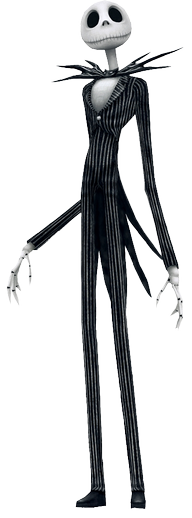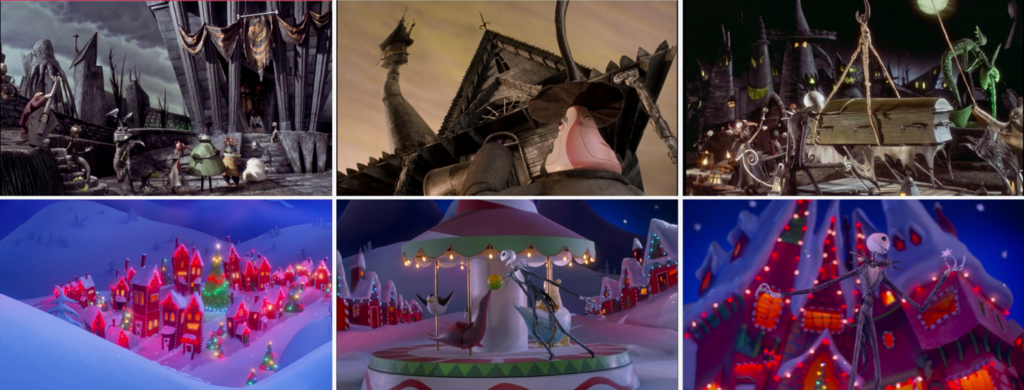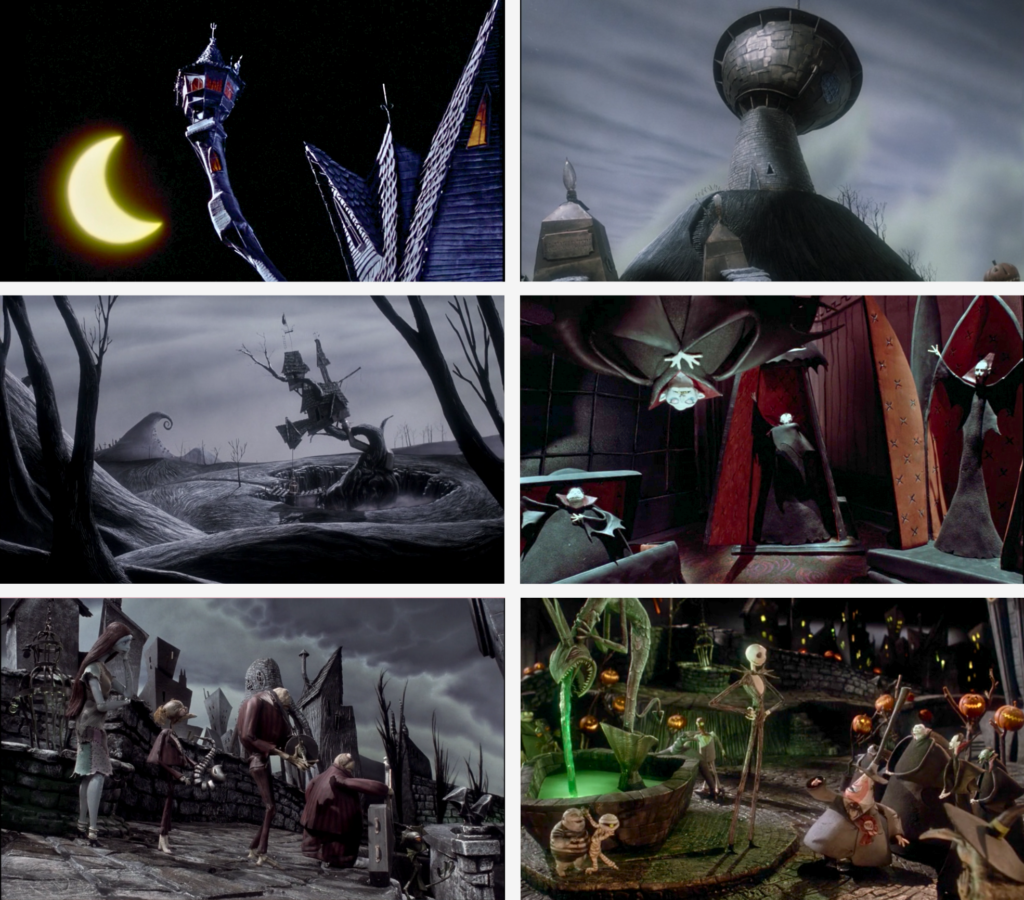It’s Halloween week and we’re plotting our trick-or-treating route, so we’re thinking walkable neighborhoods, pumpkins, and spooky celebrations which brings us to…The Nightmare Before Christmas?
You’ll often see Smart Growth Maryland here on the blog writing about how we can implement common-sense policies for sustainable growth in communities across the state, and we’re lucky in Maryland to have had several real-world Smart Growth successes. In recent years communities have passed laws to institute form-based code, allow ADUs by right, reform parking requirements, and increase (affordable) housing density among other things – all great steps toward creating more accessible, vibrant downtowns.
This Halloween, however, we’re turning to one of our favorite fictional towns to find out what it can teach us about Smart Growth and Historic Preservation. So, if you’ve ever found yourself thinking, “Should I move here??” while watching Tim Burton’s The Nightmare Before Christmas, this blog is for you.

But first, a brief synopsis for those readers who haven’t (yet) seen this Halloween classic – spoilers ahead! The Nightmare Before Christmas follows the adventures of Jack Skellington, the Pumpkin King of Halloween Town, a spooky municipality where every day is spent planning Halloween festivities and where scary is essentially a job title. But after this year’s Halloween celebration, Jack finds himself bored and dissatisfied — with the same show year after year, Halloween has lost its meaning. Overcome with ennui, he spends the night wandering in the forest outside of town, where he comes upon a patch of trees in the woods, each with a holiday-themed door: Easter, Valentine’s Day, St. Patrick’s Day, Thanksgiving, and Christmas. Jack tumbles through the Christmas door into Christmas Town, a vibrant, colorful village full of light, laughter, and snow. Totally enthralled, he determines that this year he and the citizens of Halloween Town will do Christmas themselves, crafting toys and delivering them to children while Santa takes the year off (read: is kidnapped by the children of Halloween Town). Spurred on by enthusiasm and assistance from the Halloween Town community, and unphased by the misgivings and ominous visions from his close friend, Sally, Jack “makes Christmas,” with largely disastrous results. In the end, though his Christmas did not turn out as he had hoped, Jack finds renewed passion for Halloween and appreciation for Halloween Town, and brims with ideas for next year’s celebration.
On the surface, the film is a classic “grass is always greener” cautionary tale. However, Smart Growth advocates and historic preservationists may find in it meaningful insights about the real-life impacts of smart urban design. In creating a strong, supportive, and inclusive community –one that was clearly built by and for its residents—Halloween Town’s urban design ensures that Jack’s Christmas scheme will take flight. Read on to find out how.
Vernacular Architecture

The vernacular architecture of Halloween Town (top row) and Christmas Town (bottom row) is key to differentiating the two towns not only visually, but in terms of their atmosphere and character, as well. Maryland’s real-life historic towns do the same, drawing on the historic built environment to create a unique sense of place.
Halloween Town is a quintessential mixed-use, walkable community (which would be illegal to build in many places today – modern zoning codes would not allow for it), the growth of which has not encroached on the magical, forested Hinterland which surrounds it. Architectural styles serve to differentiate Halloween and Christmas town, giving each downtown a unique sense of place and character. Halloween town is built with an eerie, exaggerated style that gives it its unique spooky, yet charming character. Christmas Town, in contrast, features townhomes in the style of Dutch renaissance canal houses, evoking gingerbread houses and creating a distinctly wintery, colorful and joyful, energy.
Zoning (Or Lack Thereof)
Maintenance of the unique architectural character of Halloween Town is aided by its apparent lack of Euclidian (use-based) zoning. If there’s any zoning at all, it appears to be form -based (design-based zoning that does not dictate building use). What is most important in Halloween Town, it seems, is that structures follow the same design and color scheme (orange, yellow, black, white, and grey). While some buildings clearly take inspiration from certain styles, like Gothic Revival or Neo-Classical, all use similar materials, colors, and designs, to create a “Halloween Town Vernacular.”
The style, which, according to the production team, primarily takes inspiration from German Expressionism, features spooky structures with irregular lines and massing which loom over the street and seem to cast elongated shadows at any time of day. Houses and municipal buildings are built around a centralized square, which features a fountain across from the oft-used town hall, providing Halloween Town citizens critical “third-spaces” to congregate and come together as a community.
Mixed-Density Housing

Halloween Town’s varied housing types. Top row: Jack Skellington’s house and Dr. Finkelstein’s house. Middle row: Lock, Shock, and Barrel’s treehouse and the Vampire Crypt. Bottom row: two images showing the gentle density of Halloween Town just outside the town square. In the film and in real life, mixed density housing fosters diverse, inclusive, sustainable communities.
No discernable zoning code also means Halloween Town is filled with a variety of creative housing types. Jack and Dr. Finkelstein have rare single-family homes within steps of downtown, seemingly the only two in town. Others live in more creative homes, like the vampires, who live in a quadplex crypt. Oogie Boogie, the main villain of the story, lives in a lair underground, while his henchmen, Lock, Shock, and Barrel, live above it in a treehouse. (It turns out that ADUs are extremely convenient housing-types for villains looking to keep their evil minions close at hand. Their proximity to his lair is key to the success of their plan to kidnap “Sandy Claws” and deliver him to Oogie).
Transit

Top row: Sally walks downtown; a witch on broomstick zooms into the town hall; Jack rides in on a snowmobile. Bottom row: The Mayor makes announcements from his city vehicle; Jack rides Christmas Town’s train; Lock, Shock, and Barrel travel via clawfoot tub. Halloween Town’s streets are suitable for many forms of transit and even Christmas Town has a train. Multimodal transit makes it easier for municipalities, real and fictional, to come together as a community.
And finally, connecting it all are Halloween Town’s transit options. Halloween Town has complete streets: streets designed for many uses, not exclusively for cars. In fact, there are very few automobiles at all in Halloween Town, nor is there any (on-street) parking. Streets that can accommodate the likes of the Mayor’s municipal vehicle, Jack’s snowmobile, wheel-chair users, pedestrians, witches on broomsticks, and even walking claw-foot tubs, make for a creepy but vibrant, downtown. It fosters a close-knit community capable of quickly coming together to take over another town’s holiday. Coordinating a scheme like this would have been much more difficult if all the Halloween Town citizens had to drive downtown for every planning meeting.
While, sadly, we cannot move to Halloween Town, we can bring the spirit of Halloween Town to our own main streets. Like Jack, we can celebrate the unique character of our communities and build upon what makes them special by continuing to advocate for Smart Growth policies in our own towns and municipalities.
And if you’re looking for something fun to do this Halloween, be sure to check out the happenings in Maryland’s 34 Main Street Communities. You’ll be sure to find something spirited and spooky!
All images in this post come from Tim Burton’s the Nightmare Before Christmas. Selick, Henry, dir. Tim Burton’s The Nightmare Before Christmas. 1993; Burbank, CA: Touchstone Pictures and Skellington Productions, 1993. https://www.disneyplus.com/en-gb/movies/tim-burtons-the-nightmare-before-christmas/5GjwOj5Rkpz2.

